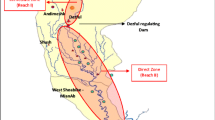Abstract
This paper presents a sediment management study through hydraulic flushing of a reservoir at a hydropower station in Kashmir, Pakistan. The study area is under the influence of monsoon rains and is part of a seismically active region along the northwestern zone of Eurasian plates. The earthquakes, glacial melts, rainfall events, along with some anthropogenic factors aggravate the sediment load in the streams. Since small reservoirs are sensitive to sedimentation, periodic flushing is required. The research methodology uses 1D river sediment model HEC-RAS to simulate a number of scenarios impacting the sedimentation rate and flushing efficiency and provision of a check dam upstream of the reservoir. Different flushing scenarios were formulated based on likely flows and assessed through three criterions: enhancing life of the power plant by keeping sediment level below the power intake level, preventing abrasion of turbines by the fine sediment particles and ensuring continued power plant operation after a flushing by checking that the flushed material does not block outflow from the tailrace. Results show that without flushing the dam would be filled up in 15 years of operation under the normal flow conditions, whereas life of the reservoir will be enhanced manifold with regular flushing leading to a significant reduction in the quantity of sediment sizes that are likely to degrade the turbines. Simulated scenario of providing a check dam upstream of the reservoir revealed that it is helpful in mitigating the flood risk to the surrounding area.

















Similar content being viewed by others
References
Ackers P (1990) Sediment transport: the Ackers and White theory revised. HR Wallingford, United Kingdom, Report No. SR 237
Ackers P, White WR (1973) Sediment transport: new approach and analysis. J Hydraul Div 99(11):2041–2060
Atkinson E (1996) The feasibility of flushing sediment from reservoirs. HR Wallingford, Wallingford
Batuca G, Jordaan Jr M (2000) Silting and desilting of reservoirs, AA Balkema. ISBN 90-5410-477-5, Rotterdam, Netherlands
Bhave VG, Neena I, Shitole MS (2001) Sedimentation profile for a reservoir across Himalayan River. Int. Semin. ‘Reservoir Sedimentation, Ooty, Tamil Nadu
Boyd PM, Gibson S (2016) Applying 1d sediment models to reservoir flushing studies: measuring, monitoring, and modeling the spencer dam sediment flush with HEC-RAS, US Army Engineer Research and Development Center Vicksburg United States
Castillo L, Carrillo J, Álvarez M (2015) Complementary methods for determining the sedimentation and flushing in a reservoir. J Hydraul Eng 141:05015004
Chang FJ, Lai JS, Kao LS (2003) Optimization of operation rule curves and flushing schedule in a reservoir. Hydrol Process 17:1623–1640
Chaudhary H, Isaac N, Tayade S, Bhosekar V (2018) Integrated 1d and 2d numerical model simulations for flushing of sediment from reservoirs. ISH J Hydraul Eng. https://doi.org/10.1080/09715010.2018.1423580
Ghoreishi SH, Tabatabai MRM (2010) Model study reservoir flushing. J Water Sci Res 2(1):1–8. ISSN:2008-5338
Gibson S, Brunner G, Piper S, Jensen M (2006) Sediment transport computations in HEC-RAS. In: Eighth federal interagency sedimentation conference (8th FISC), Reno, NV, USA
Gulliver JS, Arndt RE (1991) Hydropower engineering handbook. McGraw-Hill, New York
Isaac N, Eldho T (2017) Sediment management of run-of-river hydroelectric power project in the himalayan region using hydraulic model studies. Sādhanā 427:1193–1201
Isaac N, Eldho T, Gupta I (2014) Numerical and physical model studies for hydraulic flushing of sediment from Chamera-II reservoir, Himachal Pradesh, India. ISH J Hydraul Eng 20:14–23
Jungkyu A, Yang CT (2010) Simulation of Xiaolangdi reservoir sedimentation and flushing processes. In: 2nd joint federal interagency conference, Las Vegas
Krone RB (1962) Flume studies of the transport of sediment in estuarial shoaling processes
Morris GL, Fan J (1997) Reservoir sediment handbook. McGraw-Hill Book Co., New York
Partheniades E (1965) Erosion and deposition of cohesive soils. J Hydraul Div 91:105–139
Petkovsek G, Roca M (2014) Impact of reservoir operation on sediment deposition. In: Proceedings of ICE-water management, pp 577–584
Raza RA, Habib-ur-Rehman NMK, Akhtar N (2015) Exploring sediment management options of Mangla reservoir using ressass. Sci Int 27:4
Sayah S, Bonanni S, Heller P, Volpato M (2014) Physical and numerical modelling of Cerro del Águila Dam: hydraulic and sedimentation
Searcy JK (1959) Flow-duration curves. US Government Printing Office, Washington
Strand RI, Pemberton EL (1987) Reservoir sedimentation. In: Design of small dam. United States Bureau of Reclamation, Denver
USACE (2010) HEC-RAS River analysis system—hydraulic reference manual and user’s manual
Wen Shen H (1999) Flushing sediment through reservoirs. J Hydraul Res 37:743–757
White W (1990) Reservoir sedimentation and flushing hydrology in mountainous regions artificial reservoirs, water and slopes. IAHS Publication, Wallingford
White W, Attewill L, Ackers J, Wingfield R (2000) Guidelines for the flushing of sediment from reservoirs. Hydraulics Research Limited, Wallingford
Xiaoqing Y, Yang X (2003) Manual on sediment management and measurement. Secretariat of the World Meteorological Organization Geneva, Geneva
Yoon Y (1992) The state and the perspective of the direct sediment removal methods from reservoirs. Int J Sedim Res 7:99–115
Acknowledgements
This research is supported by Higher Education Commission, Pakistan (HEC), and Advance Studies and Research Board, University of Engineering and Technology, Taxila, Pakistan. Authors are grateful to the HEC and the Department of Civil Engineering for providing the necessary financial support and conducive environment to carry out research. Moreover, preparation of Physical Model was funded by Mira Power Limited (MPL) of Pakistan which is owner of Gulpur Hydropower Project. I thank MPL in providing all back end support and relevant data.
Author information
Authors and Affiliations
Corresponding author
Rights and permissions
About this article
Cite this article
Iqbal, M., Ghumman, A.R., Hashmi, H.N. et al. Planning of Hydraulic Flushing Schedule for Prolonging the Life of a Hydropower Plant. Iran J Sci Technol Trans Civ Eng 43 (Suppl 1), 487–501 (2019). https://doi.org/10.1007/s40996-018-0181-5
Received:
Accepted:
Published:
Issue Date:
DOI: https://doi.org/10.1007/s40996-018-0181-5




